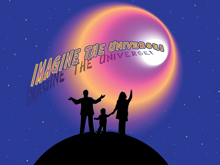Sun's Gravity Bends Starlight
Einstein's Theory Triumphs
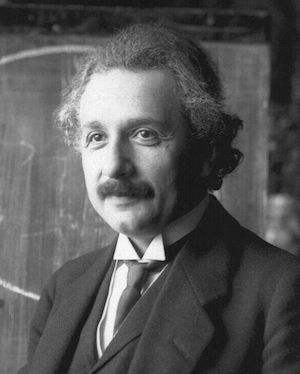
Image credit: Ferdinand Schmutzer, via Wikimedia Commons
Albert Einstein
According to Sir Joseph Thompson, "the greatest achievement in the history of human thought" was a prediction made by Dr. Albert Einstein. Dr. Einstein's prediction was proven true during the total eclipse of the sun on May 29, 1919.
Sir Joseph made this pronouncement at a joint meeting of the Royal Society and the royal Astronomical Society in London on November 6. In the audience were a large number of astronomers and physicists. The excitement in the meeting was quite obvious, and everyone agreed that the observations made during the eclipse did prove Dr. Einstein's prediction. Dr. Einstein is a Professor of Physics at the University of Berlin and Director of the Kaiser Wilhelm Physical Institute.
The Prediction

Image courtesy of the University of Texas Libraries, The University of Texas at Austin
Sir Isaac Newton
Two centuries ago Sir Isaac Newton explained how gravity works in his book Optics. According to Newton, if a ray of light from a distant star passes by the edge of a massive object, the ray should be bent by the gravity of that object. The most massive object near Earth is the Sun. According to Newton's principles, a light ray from a distant star would be bent only a very small amount by the Sun's gravity, but that change in position can be measured by taking photographs of the star when its light is passing close to the Sun and later in the year when its light is not passing close to the Sun. The photographs must be taken with great care and precision.
Newton thought of gravity as a force that pulls things toward an object; the more massive the object, the stronger the pull.
In his general theory of relativity, Dr. Einstein explains that gravity and inertia are the same. The "force" of gravity pressing you down in a chair is the same force you feel when the automobile you are in quickly slows down, and you continue to move forward. Dr. Einstein says gravity, like inertia doesn't pull. Instead, anything in space that has mass, will warp or curve space and time around it. Think of a pillow as space. If you place a heavy (massive) object on the pillow, the pillow will curve around the object. Dr. Einstein says the amount of the curvature relates directly to the mass of the object. This curvature of space is what curves the path of the ray of light from a distant star.
Dr. Einstein's theory, which is highly mathematical, predicts that the curvature of space caused by the Sun's mass should bend starlight twice as much as Newton's principles predict it should.
The amount by which starlight is bent by the Sun's mass is considered by astronomers and physicists to be the most important test of Dr. Einstein's theory of relativity.
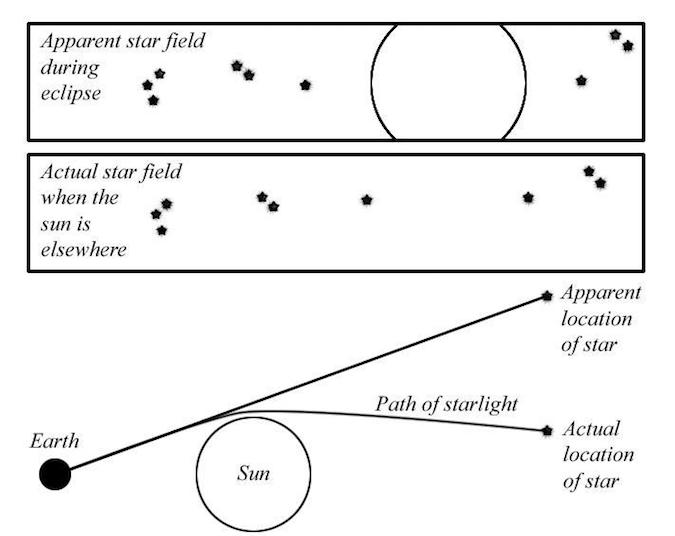
Image credit: NASA's Cosmic Times
Illustrations showing how the bending of starlight. Top: The apparent positions of the stars during the eclipse when their light is bent around the Sun. Middle: The positions of the stars when their light is not bent around the Sun. Bottom: The actual path of the light as it bends near the Sun and reaches Earth, and the apparent position of that star as a result of its light bending around the Sun.
May's solar eclipse
Dr. Einstein published his prediction in Germany in 1915 during the Great War between England and Germany. A Dutch astronomer smuggled a copy of Dr. Einstein's paper out of war-torn Europe into England where it was read by Arthur Stanley Eddington, Plumian professor of Astronomy and Experimental Philosophy at Cambridge University. This was the same position Newton held when he developed his theory of gravity.
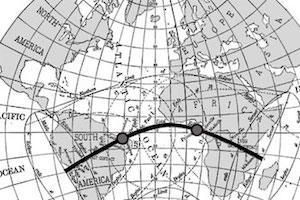
Image credit: Royal Observatory Greenwich
The path of totality for the eclipse of May 29, 1919 spanned the Atlantic (dark line); the eclipse was very long — nearly seven minutes at its maximum duration. The two dots indicate the positions of the expeditions led by Dr. Crommelin for the Royal Greenwich Observatory (left) and Prof. Eddington for Cambridge University (right).
Other astronomers had read earlier versions of Einstein's paper and tried to test his prediction during total solar eclipses in 1912 and 1914. They were not successful in their attempts due to cloudy weather and the start of the Great War. When astronomers studied the conditions of the 1919 eclipse, it appeared the Sun would be well placed in a group of bright stars. Also, the Sun's light would be totally blocked by the Moon for over five minutes which would allow enough time for the Sun and the stars to be photographed at the same time.
Professor Eddington decided to lead a group to the island of Principe near the western coast of Africa where the eclipse could be photographed. He also convinced Sir Frank Dyson, Director of the Royal Observatory, to send another group to a different location to reduce the chance that clouds might block the eclipse and prevent photographing the Sun. This other group led by Dr. Andrew Crommelin from the Royal Observatory, traveled to northern Brazil to view the eclipse.
If the weather was clear at either of these locations on the day of the eclipse, it would be possible to take a set of photographs of the totally eclipsed Sun along with a number of bright stars that appeared close to the Sun.
Results discussed
At the joint meeting, Sir Frank described the work of these two groups. The purpose of the meeting was to decide if the light coming from these stars was bent (deflected) by the Sun as it passed by. According to Sir Frank, if the Sun did affect the light, it would bend it away from the Sun, making the stars appear farther from the Sun than they actually were. The group would also need to determine how far out of position the stars would appear on the photographic plates.
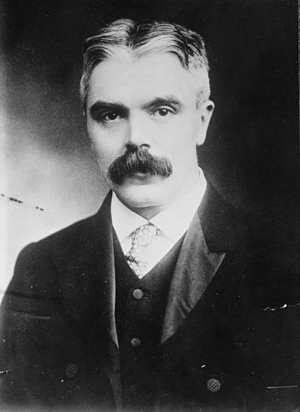
Image credit: Bain News Service via the Library of Congress
Sir Frank Dyson
The Royal Observatory party arrived in Brazil in time to prepare for the eclipse and to photograph other star fields. It was cloudy early on the day of the eclipse, but cleared later, and the observations were carried out with almost complete success. The observers remained in Brazil until July so they could photograph the same set of stars during the night sky when their light did not pass by the Sun. Between May and July the Earth had moved in its orbit, which changed the position of these stars compared to the positions of the Earth and Sun. Waiting for the Earth to move in its orbit positioned these stars in the night sky once again. Once this second set of photographs was obtained, the observers immediately returned to Greenwich where each plate was carefully measured two times.
The Cambridge University party arrived on Principe on April 23. "We soon realised that the prospects of a clear sky at the end of May were not very good," recalled Prof. Eddington. The sky was completely cloudy at the beginning of the eclipse, but about half an hour before totality they caught glimpses of the Sun through the clouds. They took photographs exactly as arranged, but only two out of 16 plates taken showed enough stars to measure. Prof. Eddington was also not able to stay on Principe for several more months to take a second set of photographs for comparison.
Sir Frank explained in detail how the observations were made, the equipment used, and the way the photographic plates were measured back at the Greenwich Observatory. He also discussed how the observed star positions during the eclipse were compared to their positions two months later when their light did not pass near the Sun. He convinced the audience at the joint meeting that the results of the experiment were definite and conclusive, and that the Sun's gravity did deflect the light. He also stated that the amount of deflection was very close to what Dr. Einstein predicted and almost twice as much as Newton's principles predicted.
"After a careful study of the plates I am prepared to say that there can be no doubt that they confirm Einstein's prediction," Sir Frank declared. "A very definite result has been obtained that light is deflected in accordance with Einstein's law of gravitation." Prof. Eddington added "we must assume that gravity obeys the new law proposed by Einstein." •


